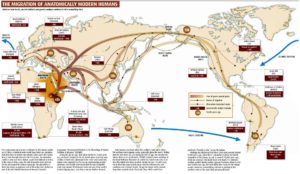Who discovered America? This simple three word question often elicits strong reactions. Why? Primarily because other than a wind-blown Chinese junk the generally accepted answers are all Europeans. As a fifth-grader I was required to write a paragraph answering this question. I dutifully wrote several sentences about the expected answer of Christopher Columbus. However being a precocious kid who’d recently read a magazine article about the Norse settlement at L’Anse aux Meadows, I concluded with a sentence proclaiming Leif Erikson the true discoverer. Citing my final sentence as contradictory (a word I had to look up), Mrs. Windt awarded me a C-.
That said, the premise of the question is what gets many people’s shorts in a knot. After all there were several million people living north of the Rio Grande when Columbus reached the ‘indies.’ Central and South America each supported more than ten million. So a more interesting question is, when did modern humans first arrive in the Americas?
With mild apologies to any creationists reading this post, modern humans first appeared ~200,000 years ago. DNA research suggests all modern humans can trace their ancestry to a female who lived in east Africa ~140,000 years ago. As for a common male the data supports the same location ~60,000 years ago. Scientists were able to determine these dates because pieces of gender related DNA pass unaltered to the next generation. Coupling the DNA techniques with archeological evidence leads to an out of Africa date no later than ~65,000 years ago. Approximately 25,000 years later modern humans had reached most of the old world and Australia, but not the Americas.
So when did they arrive in America?
There are conflicting theories about humans first arrival in the Americas. The generally accepted answer – they crossed the ice age created land-bridge between Alaska and Siberia 15-20,000 years ago. There’s ample archeological evidence (Clovis, Wally’s Beach, and Arlington Springs) to support human settlement during this time. There are proponents of earlier arrivals, such as contested footprints in Mexico dating from 38,000 years ago. Humans made it to Australia without a land-bridge, so why couldn’t they cross an incomplete bridge into the Americas, too? A recent article published in Nature suggests humans may have been present in the Americas as early as 130,000 years ago. The authors even suggest that their findings may entail a lost branch of humanity. While certainly provocative, the claims amount to little more than sketchy assertions.
Today’s Map courtesy of The Trans Pacific Project and the U.S. Department of Energy, Office of Biological and Environmental Research, Human Genome Program.
As always thanks for reading.
Armen
PS Continuing in my contradictory ways Lief’s father Erik the Red is probably a better European answer than his son. Erik founded the Norse colony in Greenland, which as everyone who’s ever played Risk knows is part of North America.
PPS In Misaligned: The Silver Scepter I propose yet another alternative theory involving an ancient lost civilization that mastered multi-dimensional science.



Nicely done, as usual. The term “modern human” is an interesting description of those who came from Europe. I’m currently reading a book: “CRO-MAGNON, How the Ice Age Gave Birth to the First Modern Man”. (Written by Brian Fagan.) The advances that have been made in Archaeology and DNA have supplied so much more info to be digested and discussed. Early humankind is really quite fascinating. On another level, it’s really got to wrangle the Native Americans when we talk about “discovering” America.
Thanks, Rick. I’m glad you enjoyed the post. I agree about the whole discovery thing. It’s very old world centric. That doesn’t make it intentionally insulting, but I can certainly see how it might rankle some.
There are the remains of a settlement in Newfoundland that suggest the vikings got here 1000 years before the Europeans.
Other than the L’Anse aux Meadows site and the well known colonies in Greenland I didn’t find any references to Viking settlements. The ‘Meadows’ site dates from around 1000 so it predates Columbus by almost 500 years. There is an Irish claim to ‘discovering America’ by St. Brendan in the 6th century. That would beat Columbus by 1,000 years. While there is a St. Brendan Society that celebrates this notion, I’m not aware of any archeological evidence to support their celebration.
Interesting article, thank you!
Fran, thanks for letting me know. I’m glad you liked the post. I certainly enjoyed doing the research for it.